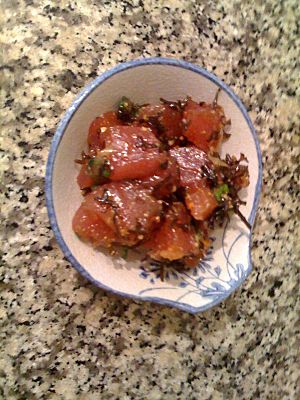Limu (algae) facts for kids

Limu, also called rimu or ʻimu, is a special word from Polynesia. It means plants that grow in or near water. Think of it like seaweed or algae. People in Hawaii have about 100 names for different kinds of limu! Many types of limu are good to eat. They are used in cooking all over Polynesia.
Contents
How People Use Limu
Many kinds of limu are eaten as food across Polynesia. People usually eat it raw with their meals, especially with fish.
In Hawaii, limu was a very important part of the Hawaiian diet. It was eaten along with fish and poi. Hawaiians even grew different types of seaweed for food. They also used it to feed fish in their special fish ponds. About 75 types of limu were used for food in Hawaii. This is even more than the 35 types used in Japanese cuisine, which is also famous for using seaweed. Today, limu is often used as a topping or side dish. It is especially popular in raw fish dishes like poke.
Limu was also used in hoʻoponopono. This was an old Hawaiian way to solve disagreements. People who had problems would gather to pray and ask for forgiveness. They would eat limu kala leaves to show they were making up. Limu is also used in traditional hula dancing clothes. Sometimes, it is even used as medicine.
The Maori people also call a native tree Dacrydium cupressinum by the name rimu. This is because its leaves look like some types of limu.
Different Types of Limu
Limu comes from many different plant groups, called genera.
Limu in Hawaii
- Limu ‘ele‘ele (Enteromorpha prolifera)
- Limu kala (Sargassum echinocarpum) – used in hoʻoponopono.
- Limu koele – means "dry or hard" limu.
- Limu a kohu (Asparagopsis taxiformis) – this is a very popular type.
- Limu huluhulu waena – a favorite of Liliʻuokalani.
- Limu hina (Hypnea spp.)
- Limu lipoa (Dictyopteris plagiogramma) – used to grow in large beds around O‘ahu. It disappeared from Waikiki Beach in the 1960s. This happened because of pollution and a fast-growing plant called Gracilaria salicornia.
- Limu loloa (Gymnogongrus long or slender)
- Limu manauea (Gracilaria coronopifolia, also called ogo in Japanese) – cooked with meats to make a tasty jelly. It is also diced raw with poke, chili, and salt.
- Limu palahalaha (Ulva fasciata) – used in hula dancing.
- Limu wawae‘iole (Codium edule)
- Pakaiea (green sea lettuce) – named after a shark god.
- Lepelepe-o-Hina – means "shawl of the goddess Hina". This name is also used for a native butterfly and a type of sea slug.
Limu in New Zealand
- Kapoke whero (Gracilaria chilensis)
- Karengo (Pyropia spp.)
- Karepō (Zostera spp.)
- Rehia (Gigartina spp.)
- Rimurapa (Durvillaea antarctica)
- Rimurimu (Caulerpa brownii)
- Rimurimu kura (Polysiphonia spp.)
- Rimu akau (Sargassum spp.)
- Rimu kai (Caulerpa racemosa)
- Rimu oma (Hydroclathrus spp.)
- Rimu taratara (Turbinaria spp.)
Limu in Niue
- Limu fua (Caulerpa racemosa)
- Limu tahi (Caulerpa cupressoides)
Limu in Samoa
- A ʻau (Halymenia spp.)
- Fuofua (Caulerpa racemosa)
- Limu aau (Gracilaria spp.)
- Limu lautalatala (Turbinaria spp.)
- Limu vaova (Sargassum spp.)
Limu in Tonga
- Fuofua (Caulerpa peltata)
- Kaka (Caulerpa serrulata/Caulerpa cupressoides)
- Limu vai (Hypnea charoides)
- Louniu (Caulerpa sertularoides)
- Palalafa (Caulerpa scalpeliformis)
- Tangau (Cladosiphon spp.)
- Toke (Caulerpa racemosa)
Threats to Limu
It has become harder to find limu. This is because of too much picking, pollution, and building in areas near water. Many important kinds of limu grow best in brackish water. This is where fresh water mixes with sea water.
Another problem for limu is the spread of new plants that are not native. These are called invasive species. They can take over the areas where limu grows. Some examples are Kappaphycus (smothering seaweed), Gracilaria salicornia (gorilla ogo), Avrainvillea amadelpha (leather mudweed), Hypnea musciformis (hook weed), and Acanthophora spicifera (prickly seaweed).

